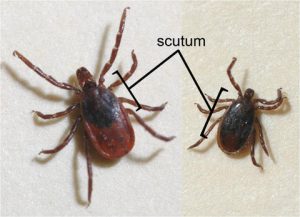Keep your eyes open for ticks!
Published on May 1, 2023 at 1:42pm CDT
Growing Green
By Robin Trott, Extension Educator
You would think that this later than normal spring would delay the tick season. Well, think again, I pulled several ticks off of my cats last week. If you have been spending time outside, chances are you’ve seen a tick or two. In Minnesota, there are two types of ticks we come across on a regular basis: The wood tick and the black legged tick (formerly called the deer tick). One is a harmless nuisance, the other transmits Lyme disease.
 The wood tick is dark brown with whitish or yellowish markings. They are most active in the early summer months, and can be found in open fields and the underbrush of hardwood forests. They feed on a wide variety of mammals, including white-footed mice, voles, chipmunks, raccoons, squirrels, dogs, cats and people. Unfed males and females are under ¼” in length. Females will be up to ½” long after feeding and resemble a grape. Males do not greatly differ in size or shape after feeding.
The wood tick is dark brown with whitish or yellowish markings. They are most active in the early summer months, and can be found in open fields and the underbrush of hardwood forests. They feed on a wide variety of mammals, including white-footed mice, voles, chipmunks, raccoons, squirrels, dogs, cats and people. Unfed males and females are under ¼” in length. Females will be up to ½” long after feeding and resemble a grape. Males do not greatly differ in size or shape after feeding.
 Black legged ticks are significantly smaller than wood ticks, 1/8” or smaller. They have a distinctive reddish-brown apron, and black heads and legs. They most commonly feed on mice and deer, but can be found on other mammals, birds and people. Black legged ticks live in wooded areas, and can be found in the leaf duff and debris of the forest floor. These ticks are significant because they can carry Lyme disease. In Minnesota, the highest risk of Lyme disease occurs in the southeast, east central and north central areas of the state. Most cases of Lyme disease occur in June and July due to bites from infected nymphal ticks, although cases have been reported in Minnesota from February through November. Lyme disease is a bacterial infection whose symptoms include: fever, headache, fatigue and a characteristic bulls-eye skin rash. If left untreated, infection can spread to joints, the heart and the nervous system. If you suspect that you or your child has been bitten by a black legged tick, consult a physician. If you remove a tick from a loved one, place it in a sealed container and freeze it for later identification purposes.
Black legged ticks are significantly smaller than wood ticks, 1/8” or smaller. They have a distinctive reddish-brown apron, and black heads and legs. They most commonly feed on mice and deer, but can be found on other mammals, birds and people. Black legged ticks live in wooded areas, and can be found in the leaf duff and debris of the forest floor. These ticks are significant because they can carry Lyme disease. In Minnesota, the highest risk of Lyme disease occurs in the southeast, east central and north central areas of the state. Most cases of Lyme disease occur in June and July due to bites from infected nymphal ticks, although cases have been reported in Minnesota from February through November. Lyme disease is a bacterial infection whose symptoms include: fever, headache, fatigue and a characteristic bulls-eye skin rash. If left untreated, infection can spread to joints, the heart and the nervous system. If you suspect that you or your child has been bitten by a black legged tick, consult a physician. If you remove a tick from a loved one, place it in a sealed container and freeze it for later identification purposes.
Prevention is the best method to avoid ticks. Take precautionary measures when you are in tick prone areas. Stay on trails and out of tall grasses. Wear protective clothing including long sleeve shirts and long pants, tucking pants in socks as an additional safeguard.
There are products available such as DEET that can be applied to clothes or skin, as well as permethrin that can be applied to clothes that can help to safeguard against ticks. Peramone (Permethrin) kills ticks as well as repels them, but should only be applied to clothes. It is effective for several wearings and will be effective if clothing is washed.
When using these products, always read the directions and precautions carefully. Be especially cautious about the use of insect repellants on children. Be sure to use formulations designed for children and avoid applying these products to a child’s hands or face. If you are in areas common to harboring ticks, be mindful to inspect yourself and children as well as any pets that are with you. Inspect all clothing, shoes and hair for ticks, particularly before entering the home. It is recommended to do a complete body check followed by a shower and vigorous towel dry. Make sure children are examined thoroughly, especially in their hair. Check with your veterinarian about prevention and treatment of ticks on pets.
* * * * * * * * * * * * * *
“If all mankind were to disappear, the world would regenerate back to the rich state of equilibrium that existed ten thousand years ago. If insects were to vanish, the environment would collapse into chaos.” ~E. O. Wilson




